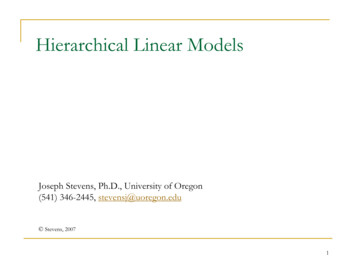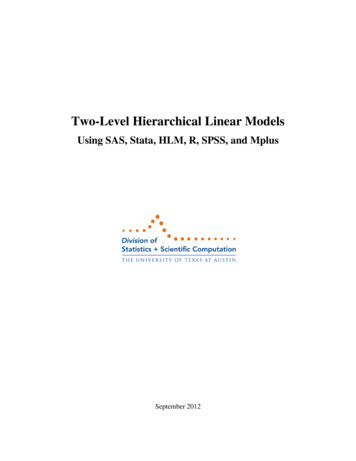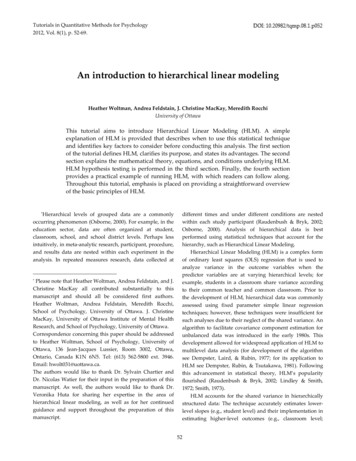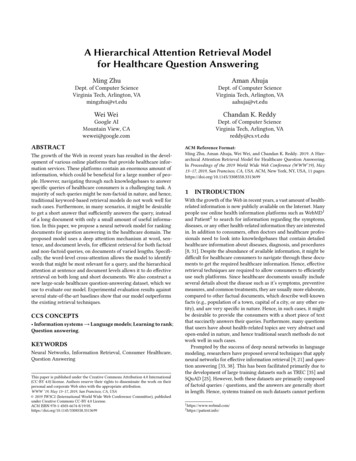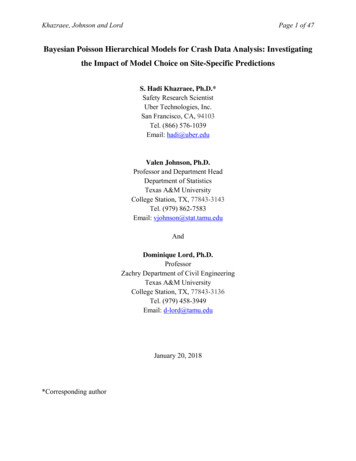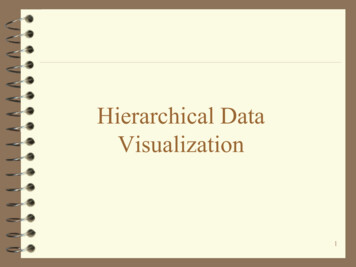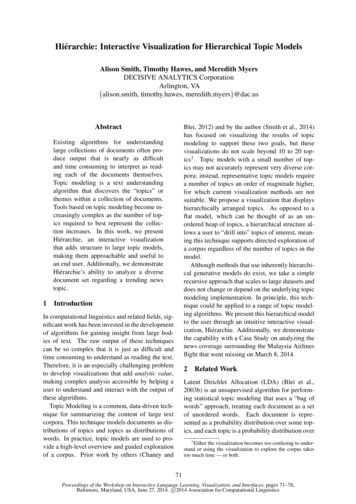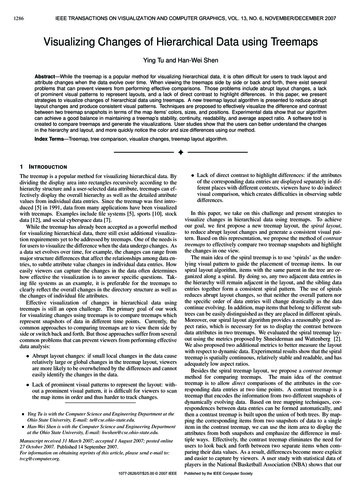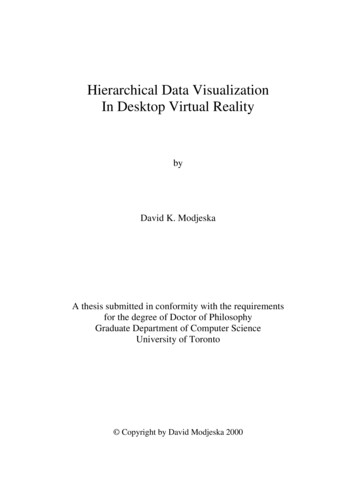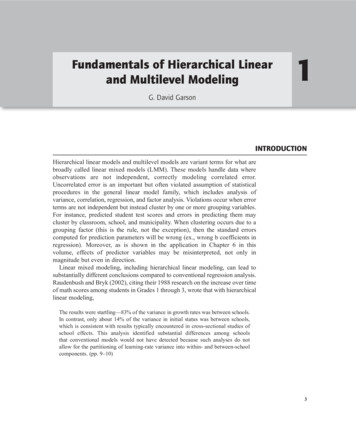
Transcription
Fundamentals of Hierarchical Linearand Multilevel Modeling1G. David GarsonINTRODUCTIONHierarchical linear models and multilevel models are variant terms for what arebroadly called linear mixed models (LMM). These models handle data whereobservations are not independent, correctly modeling correlated error.Uncorrelated error is an important but often violated assumption of statisticalprocedures in the general linear model family, which includes analysis ofvariance, correlation, regression, and factor analysis. Violations occur when errorterms are not independent but instead cluster by one or more grouping variables.For instance, predicted student test scores and errors in predicting them maycluster by classroom, school, and municipality. When clustering occurs due to agrouping factor (this is the rule, not the exception), then the standard errorscomputed for prediction parameters will be wrong (ex., wrong b coefficients inregression). Moreover, as is shown in the application in Chapter 6 in thisvolume, effects of predictor variables may be misinterpreted, not only inmagnitude but even in direction.Linear mixed modeling, including hierarchical linear modeling, can lead tosubstantially different conclusions compared to conventional regression analysis.Raudenbush and Bryk (2002), citing their 1988 research on the increase over timeof math scores among students in Grades 1 through 3, wrote that with hierarchicallinear modeling,The results were startling—83% of the variance in growth rates was between schools.In contrast, only about 14% of the variance in initial status was between schools,which is consistent with results typically encountered in cross-sectional studies ofschool effects. This analysis identified substantial differences among schoolsthat conventional models would not have detected because such analyses do notallow for the partitioning of learning-rate variance into within- and between-schoolcomponents. (pp. 9–10)3
4PA RT I . G U I D ELinear mixed models are a generalization of general linear models to bettersupport analysis of a continuous dependent variable for the following:1. Random effects: For when the set of values of a categorical predictor variable are seennot as the complete set but rather as a random sample of all values (ex., when thevariable “product” has values representing only 30 of a possible 142 brands). Randomeffects modeling allows the researcher to make inferences over a wider populationthan is possible with regression or other general linear model (GLM) methods.2. Hierarchical effects: For when predictor variables are measured at more than onelevel (ex., reading achievement scores at the student level and teacher–studentratios at the school level; or sentencing lengths at the offender level, gender ofjudges at the court level, and budgets of judicial districts at the district level). Theresearcher can assess the effects of higher levels on the intercepts and coefficientsat the lowest level (ex., assess judge-level effects on predictions of sentencinglength at the offender level).3. Repeated measures: For when observations are correlated rather than independent(ex., before–after studies, time series data, matched-pairs designs). In repeatedmeasures, the lowest level is the observation level (ex., student test scores on multipleoccasions), grouped by observation unit (ex., students) such that each unit (student)has multiple data rows, one for each observation occasion.The versatility of linear mixed modeling has led to a variety of terms for themodels it makes possible. Different disciplines favor one or another label, anddifferent research targets influence the selection of terminology as well. Theseterms, many of which are discussed later in this chapter, include random interceptmodeling, random coefficients modeling, random coefficients regression, randomeffects modeling, hierarchical linear modeling, multilevel modeling, linear mixedmodeling, growth modeling, and longitudinal modeling. Linear mixed models insome disciplines are called “random effects” or “mixed effects” models. Ineconomics, the term “random coefficient regression models” is used. In sociology,“multilevel modeling” is common, alluding to the fact that regression interceptsand slopes at the individual level may be treated as random effects of a higher(ex., organizational) level. And in statistics, the term “covariance componentsmodels” is often used, alluding to the fact that in linear mixed models one maydecompose the covariance into components attributable to within-groups versusbetween-groups effects. In spite of many different labels, the commonality is thatall adjust observation-level predictions based on the clustering of measures atsome higher level or by some grouping variable.The “linear” in linear mixed modeling has a meaning similar to that in regression: There is an assumption that the predictor terms on the right-hand side of theestimation equation are linearly related to the target term on the left-hand side. Ofcourse, nonlinear terms such as power or log functions may be added to the predictor side (ex., time and time-squared in longitudinal studies). Also, the target variablemay be transformed in a nonlinear way (ex., logit link functions). Linear mixedmodel (LMM) procedures that do the latter are “generalized” linear mixed models.
CHAPTER 1 . Fu ndame ntal s of Hierarchical L i n ear a n d Multilevel Modeli n g5Just as regression and GLM procedures can be extended to “generalized generallinear models” (GZLM), multilevel and other LMM procedures can be extended to“generalized linear mixed models” (GLMM), discussed further below.Linear mixed models for multilevel analysis address hierarchical data, such aswhen employee data are at level 1, agency data are at level 2, and department dataare at level 3. Hierarchical data usually call for LMM implementation. While mostmultilevel modeling is univariate (one dependent variable), multivariate multilevelmodeling for two or more dependent variables is available also. Likewise, modelsfor cross-classified data exist for data that are not strictly hierarchical (ex., as whenschools are a lower level and neighborhoods are a higher level, but schools mayserve more than one neighborhood).The researcher undertaking causal modeling using linear mixed modelingshould be guided by multilevel theory. That is, hierarchical linear modeling postulates that there are cross-level causal effects. Just as regression models postulatedirect effects of independent variables at level 1 on the dependent variable at level1, so too, multilevel models specify cross-level interaction effects between variables located at different levels. In doing multilevel modeling, the researcherpostulates the existence of mediating mechanisms that cause variables at onelevel to influence variables at another level (ex., school-level funding may positively affect individual-level student performance by way of recruiting superiorteachers, made possible by superior financial incentives).Multilevel modeling tests multilevel theories statistically, simultaneouslymodeling variables at different levels without necessary recourse to aggregation or disaggregation.1 Aggregation and disaggregation as used in regressionmodels run the risk of ecological fallacy: What is true at one level need not betrue at another level. For instance, aggregated state-level data on race and literacy greatly overestimate the correlation of African American ethnicity withilliteracy because states with many African Americans tend to have higherilliteracy for all races. Individual-level data shows a low correlation of raceand illiteracy.WHY USE LINEAR MIXED/HIERARCHICAL LINEAR/MULTILEVEL MODELING?Why not just stick with tried-and-true regression models for analysis of data?The central reason, noted above, is that linear mixed models handle randomeffects, including the effects of grouping of observations under higher entities(ex., grouping of employees by agency, students by school, etc.). Clustering ofobservations within groups leads to correlated error terms, biased estimates ofparameter (ex., regression coefficient) standard errors, and possible substantivemistakes when interpreting the importance of one or another predictor variable.Whenever data are sampled, the sampling unit as a grouping variable may wellbe a random effect. In a study of the federal bureaucracy, for instance, “agency”
6PA RT I . G U I D Emight be the sampling unit and error terms may cluster by agency, violatingordinary least squares (OLS) assumptions.Unlike OLS regression, linear mixed models take into account the fact thatover many samples, different b coefficients for effects may be computed, one foreach group. Conceptually, mixed models treat b coefficients as random effectsdrawn from a normal distribution of possible b’s, whereas OLS regression treatsthe b parameters as if they were fixed constants (albeit within a confidence interval). Treating “agency” as a random rather than fixed factor will alter and makemore accurate the ensuing parameter estimates. Put another way, the misestimation of standard errors in OLS regression inflates Type 1 error (thinking there isrelationship when there is not: false positives), whereas mixed models handlethis potential problem. In addition, LMM can handle a random sampling variable like “agencies,” even when there are too many agencies to make intodummy variables in OLS regression and still expect reliable coefficients.In summary, OLS regression and GLM assume error terms are independentand have equal error variances, whereas when data are nested or cross-classifiedby groups, individual-level observations from the same upper-level group willnot be independent but rather will be more similar due to such factors as sharedgroup history and group selection processes. While random effects associatedwith upper-level random factors do not affect lower-level population means, theydo affect the covariance structure of the data. Indeed, adjusting for this is a centralpoint of LMM models and is why linear mixed models are used instead of regression and GLM, which assume independence.It is true that analysis of variance and other GLM methods have been adaptedto handle non-independent models also, but these adaptations are problematic.In estimating model parameters when there are random effects, it is necessary toadjust for the covariance structure of the data. The adjustment made by GLMassumes uncorrelated error (that is, it assumes data independence). Lack of dataindependence is present in multilevel data when the sampling unit (ex., cities,schools, agencies) displays intraclass correlation. LMM does not assume dataindependence. In addition to handling correlated error, LMM also has the advantage of using maximum likelihood (ML) and restricted maximum likelihood(REML) estimation. GLM produces optimum estimates only for balanceddesigns (where the groups formed by the factors are equal in size), whereas MLand REML yield asymptotically efficient estimators even for unbalanceddesigns. ML and REML estimates are normal for large samples (they displayasymptotic normality), allowing significance testing of model covarianceparameters, something difficult to do in GLM. In contrast, GLM estimatesparameters as if they were fixed, calculating variance components based onexpected mean squares.Logistic regression also does not provide for random effects variables, nor (evenin the multinomial version) does it support near-continuous dependents (ex., testscores) with a large number of values. Binning such variables into categories, asis sometimes done, loses information and attenuates correlation. However, logistic
CHAPTER 1 . Fu ndame ntal s of Hierarchical L i n ear a n d Multilevel Modeli n g7multilevel models are possible using generalized linear mixed modeling procedures, available in SPSS, SAS, and other statistical packages.TYPES OF LINEAR MIXED MODELSLinear mixed modeling supports a very wide variety of models, too extensive toenumerate here. As mentioned above, different disciplines and authors haveemployed differing labels for specific types of models, adding to the seemingcomplexity of the subject. In this section, the most common types of models aredefined, using the most widely applied labels.The “types” refer to various combinations of what is being predicted and whatis doing the predicting. In ordinary regression, the researcher normally is predicting a level 1 (typically individual subject level) dependent variable such as“employee performance score” from one or more level 1 independent variables(ex., from “employee education”). In the multilevel world of linear mixed modeling, however, there are other possibilities. Let level 2 be defined by the groupingvariable “agency” and a level 2 variable such as “mean agency education,” withthe multilevel theory being that the presence of more highly educated employeesin an agency has a synergistic effect at the level of the individual. The level 2grouping variable may have an effect on the intercept (mean score) at level 1 and/or on the b coefficient (slope) of education at level 1. Likewise, the level 2 predictor, mean agency education, may have an effect on the level 1 intercept and thelevel 1 slope. These possibilities give rise to the types of models depicted inFigures 1.1 (see page 10) and 1.2 (see page 11).There are three broad classes of models: fixed effects, random effects, andmixed. Most models treated in this book are mixed, hence the term “linear mixedmodeling.”1. Fixed effects models. Linear mixed modeling is mostly about models involving random effects as well as fixed effects. In mixed models, effects that impactthe intercept (representing the mean of the dependent variable when other predictors are zero) are modeled as fixed effects. However, purely fixed effects modelssuch as ordinary regression models may be fitted also. These are models with onlyfixed factors and optional fixed covariates as predictors. An example would be astudy of employee performance score by education, controlling for gender. Mostmodels for analysis of variance, regression, and GLM are fixed effects models.These are the most common type of model in social science. Compared to an OLSregression model, a fixed effects model implemented in LMM will generate verysimilar if not identical estimates with similar (but not identical) output tables.2. Random effects models. Random effects models are those with one ormore random factors and optional covariates as predictors. Effects that influence the covariance structure are modeled as random factors. Sampling variables
8PA RT I . G U I D E(ex., state, where individuals are sampled within a sample of states; subject,where a sample of subjects have repeated measures over time) are random factors, as is any grouping variable where the clustering of effects creates correlatederror. An example would be a study of employee performance score at level 1 byagency at level 2, controlling for salary level at level 1. Score would be thedependent variable, agency the random factor (assuming only a random sampleof agencies were studied), and salary the covariate. The level 1 intercept of scoremay be modeled as a random effect of agency at level 2. Likewise, the level 1slope of employee education might be modeled as a random effect of agency. Ifonly the intercept is modeled, it is a random intercept model.2 If the slope ismodeled as well, it is a random coefficients model. Some authors use the term“hierarchical linear model” to refer to random effects models in which bothintercepts and slopes are modeled.3. Mixed models. Mixed models, naturally, are ones with both fixed and random effects. A given effect may be both fixed and random if it contributes to boththe intercept and the covariance structure for the model. Predictors at any levelare typically included as fixed effects. For instance, covariates at level 2 are normally included as fixed effect variables. Slopes of variables at lower levels maybe random effects of higher-level variables. Grouping variables (ex., school,agency) at any level are random factors.Hierarchical linear models (HLM) are a type of mixed model with hierarchicaldata—that is, where nested data exist at more than one level (ex., student-leveldata and school-level data, with students nested within schools). In explaining adependent variable, HLM models focus on differences between groups (ex.,schools) in relation to differences within groups (ex., among students withinschools). While it is possible to construct one-level models in linear mixedmodeling, most use of LMM can be seen as one or another form of HLM, so thetwo terms are often used synonymously in spite of nuanced differences.Random intercept models are models where only the intercept of the level 1dependent variable is modeled as an effect of the level 2 grouping variable andpossibly other level 1 or level 2 (or higher) covariates. Random coefficients models are ones where the coefficient(s) of lower-level predictor(s) is/are modeled aswell. There are several major types of random intercept and random coefficientmodels, enumerated below (see Table 1.1). The null model, also called the “unconditional model” or a “one-wayANOVA with random effects,” is a type of random intercept model that predictsthe level 1 intercept of the dependent variable as a random effect of the level 2grouping variable, with no other predictors at level 1 or 2 in a two-level model.For instance, differences in mean performance scores may be analyzed in termsof the random effect of agency at level 2. The researcher is testing to see if thereis an agency effect. The null model is used to calculate the intraclass correlationcoefficient (ICC), which is a test of the need for mixed modeling as discussed in
CHAPTER 1 . Fu ndame ntal s of Hierarchical L i n ear a n d Multilevel Modeli n gChapter 2. The null model also serves as a “baseline model” for purposes ofcomparison with later, more complex models. Note that a model is “conditional”by the presence of predictors at level 1 or level 2. Since the researcher almostalways employs predictor variables and is not simply interested in the null model,most mixed models are conditional. The central point of LMM often is to assessthe difference between the researcher’s conditional model and the null modelwithout predictors. The likelihood ratio test (discussed in Chapter 2) can be usedto assess this difference. One-way ANCOVA with random effects models. It is also possible to have alevel 1 covariate and still predict the level 1 intercept (but not the slope of the level 1covariate) as a random effect of the level 2 grouping variable, with no other level 2predictors. For instance, differences in mean performance scores (the intercepts)may be analyzed as predicted by salary at level 1, predicting only the level 1 intercept of performance scores in terms of the between-groups effect of agency as agrouping variable. Random intercept regression models are also called “means-as-outcomesregression models.” This variant of the random intercept model predicts the level 1intercept on the basis of the level 2 grouping variable and also on the basis of oneor more level 2 random effect predictors. For instance, differences in mean performance scores (the intercepts) may be analyzed, predicting the level 1 interceptin terms of the between-groups effect of agency and the level 2 random effectvariable EquipmentBrand (a factor representing a sample of some of many brandsof equipment, where different agencies used different brands). Random intercept ANCOVA models are also called “means-as-outcomesANCOVA models.” This type is simply a random intercept regression model inwhich there is also a level 1 covariate treated as a fixed effect (slope not predictedby level 2). Some authors would classify this as another type of random interceptregression model. Random coeffi
Linear mixed modeling, including hierarchical linear modeling, can lead to substantially different conclusions compared to conventional regression analysis. Raudenbush and Bryk (2002), citing their 1988 research on the increase over time of math scores among students in Grades 1 through 3, wrote
